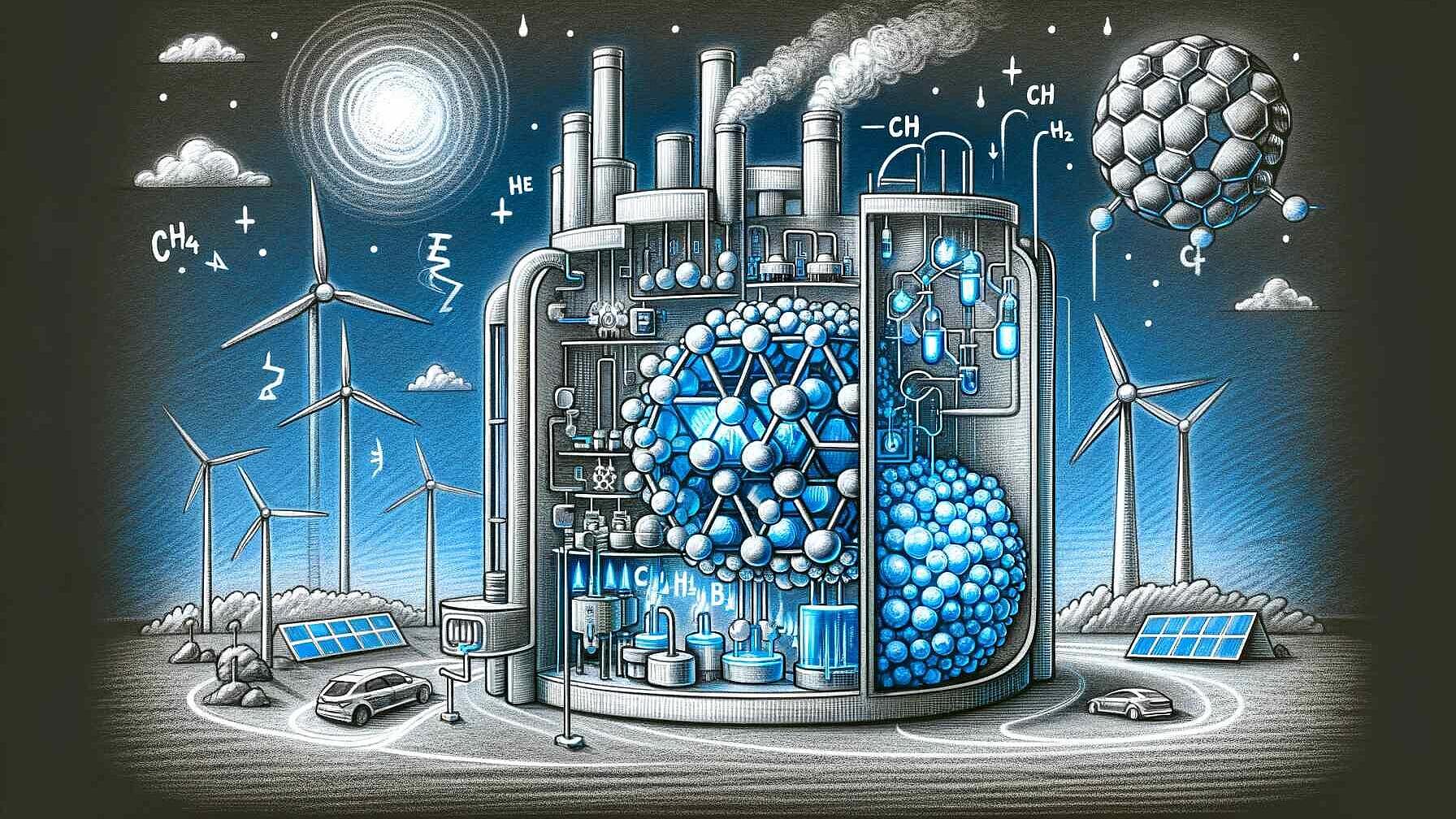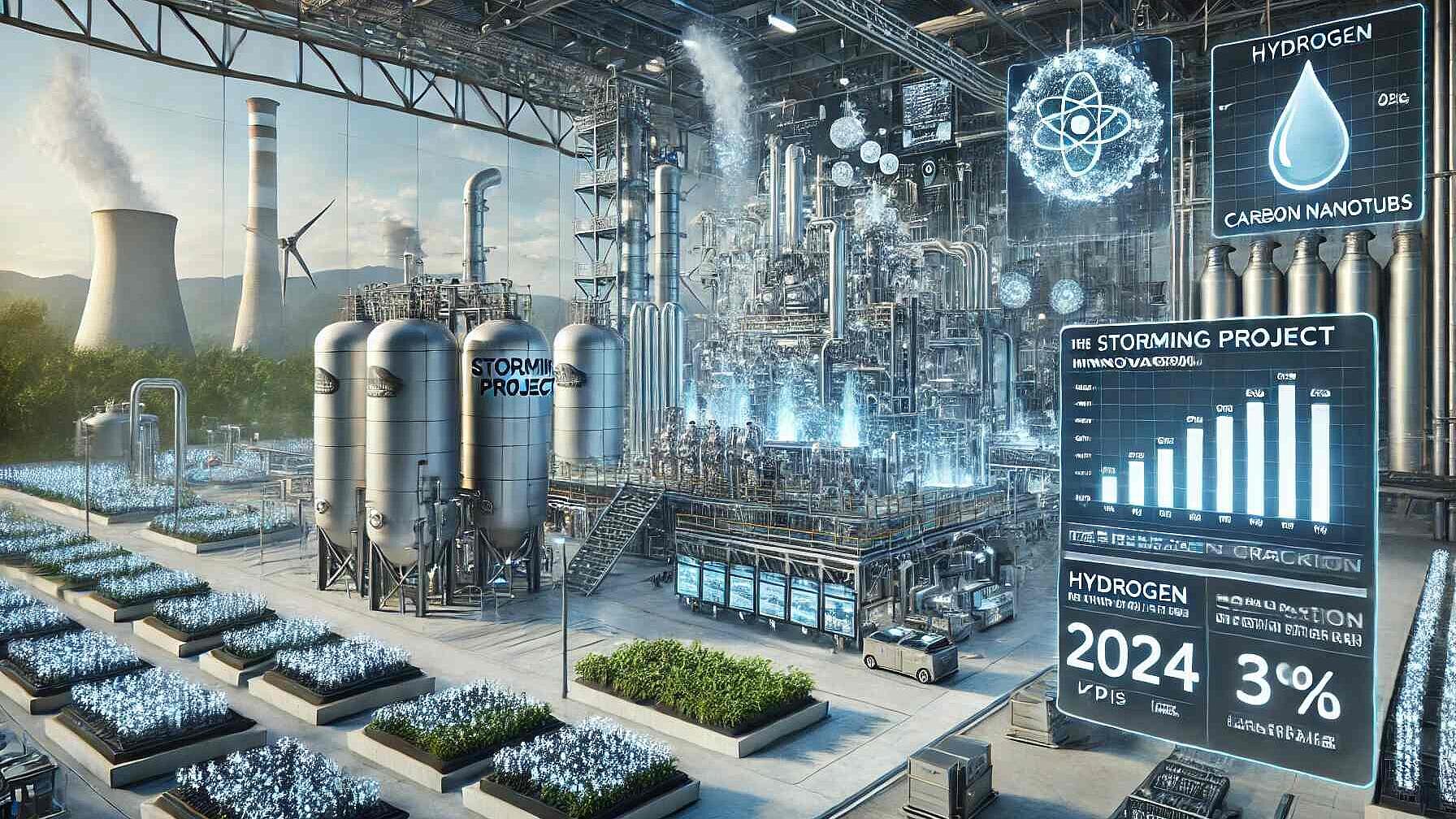 Renewable Energy
Renewable EnergyPráticas Comerciais
Catalytic Hydrogen Production: Pioneering Clean Energy with Methane Cracking
Resumo
The paper discusses the importance of hydrogen as a sustainable energy source and the innovative role of methane cracking in producing hydrogen without CO2 emissions. The conventional method of producing hydrogen, steam methane reforming (SMR), is carbon-intensive. Methane cracking, on the other hand, breaks methane into hydrogen and solid carbon, a method being advanced by the EU's STORMING project, which utilizes structured catalytic reactors powered by renewable electricity, also producing valuable carbon nanotubes (CNTs).
The STORMING project tackles reactor and catalyst efficiency, using iron-based catalysts and waste-free methods for CNT harvesting and catalyst regeneration, addressing carbon buildup and heat transfer challenges. Structured reactors for the project are designed to operate continuously and can be scaled from small to large industrial applications.
With the dual production of hydrogen and carbon nanotubes, methane cracking offers economic benefits, enabling the production of hydrogen alongside high-demand CNTs, utilized particularly in battery technology. The scalability of this technology supports various applications, potentially reducing the carbon footprint significantly. The paper emphasizes the opportunity for students and professionals to engage with this clean energy technology through education or participation in projects like STORMING. Methane cracking supports the integration of renewable energy into industrial processes and a decentralized energy system, suggesting a path toward a sustainable hydrogen-powered future.
Artigo aberto completo
Catalytic Hydrogen Production: Pioneering Clean Energy with Methane Cracking
In the race to decarbonize the world’s energy systems, hydrogen stands out as one of the most promising fuels for a cleaner future. A significant part of this transformation is methane cracking, an innovative technology with the potential to produce hydrogen without emitting CO2. At the forefront of this breakthrough is the EU’s STORMING project, which is pioneering structured reactors powered by renewable electricity to convert methane into hydrogen and high-value carbon nanomaterials. This article explores how methane cracking is shaping the future of hydrogen production and the energy landscape.
The Current State of Hydrogen Production
Hydrogen is often hailed as a crucial player in the global shift to sustainable energy, with applications ranging from fuel cells in vehicles to industrial uses. Currently, most of the hydrogen produced globally is derived from natural gas through a process called steam methane reforming (SMR), which emits significant amounts of CO2. According to recent estimates, hydrogen production from fossil fuels is responsible for over 830 million tons of CO2 annually—an environmental challenge that must be overcome to unlock hydrogen’s full potential.
However, alternative methods of hydrogen production are emerging. One of the most promising is methane cracking, which uses a catalyst to break methane (CH4) into hydrogen (H2) and solid carbon (C), eliminating CO2 emissions in the process. The STORMING project, funded by the EU’s Horizon Europe program, focuses on advancing methane cracking technology using structured catalytic reactors powered by renewable electricity. This approach not only aims to produce CO2-free hydrogen but also creates valuable carbon nanotubes (CNTs) as a byproduct, which have numerous applications in fields like electronics and battery technology.
Innovations Powering Methane Cracking
Methane cracking is not without its challenges, particularly in reactor design and catalyst performance. Traditional reactors struggle with issues like carbon buildup, which can deactivate catalytic sites, and inefficient heat transfer, which hampers productivity. The STORMING project addresses these hurdles by developing breakthrough catalytic reactors with enhanced efficiency and scalability.
At the heart of this innovation are structured reactors that operate continuously, ensuring consistent hydrogen production. These reactors are designed to optimize heat transfer using renewable electricity, with advanced heating methods like Joule heating, microwave absorption, and induction heating. This electrification of reactors is a game-changer, as it aligns hydrogen production with the availability of renewable energy, making the process more sustainable and reducing the reliance on fossil fuels.
One of the standout features of STORMING’s technology is its use of iron-based catalysts, which are both non-toxic and highly effective for CNT production. These catalysts are designed to withstand high temperatures, offering better stability and activity compared to traditional nickel-based catalysts. The project also incorporates waste-free protocols for harvesting CNTs and regenerating catalysts, enhancing the sustainability and economic viability of the process.
Real-World Applications and Economic Benefits
The dual production of hydrogen and carbon nanotubes is what makes methane cracking so attractive. Hydrogen, as a clean energy carrier, can power everything from homes to heavy industry, while carbon nanotubes are increasingly sought after for use in advanced materials, particularly in the growing field of battery technology. This synergy between hydrogen and CNTs creates a unique opportunity to lower the cost of hydrogen production while creating new revenue streams from carbon byproducts.
STORMING’s technology is designed to be scalable, with reactor capacities ranging from 100 kilograms of hydrogen per day to over 10,000 kilograms in larger installations. This scalability is critical for widespread adoption, as it allows the technology to be implemented in various industrial settings, from small-scale decentralized hydrogen production to large-scale applications in industries like steel and chemicals.
A Path to a Sustainable Future
The long-term impact of methane cracking technology on the energy industry could be profound. By eliminating CO2 emissions from hydrogen production, it has the potential to significantly reduce the carbon footprint of various sectors. For students and young professionals interested in clean energy, methane cracking offers exciting opportunities for research, entrepreneurship, and innovation. With a growing demand for sustainable technologies, expertise in areas like catalytic reactors, carbon nanomaterials, and hydrogen production will be in high demand, creating new career paths in both academia and industry.
Moreover, methane cracking aligns with broader goals of the energy transition, such as integrating renewable energy into industrial processes and reducing dependence on fossil fuels. The ability to produce hydrogen on-site, using renewable electricity, further enhances its appeal by reducing transportation costs and infrastructure needs. As the world moves toward a more decentralized energy system, technologies like those developed by STORMING will play a key role in enabling local, sustainable hydrogen production.
Seizing the Hydrogen Opportunity
For those inspired by the potential of methane cracking, now is the time to get involved. Whether you’re a student, a researcher, or a professional in the energy sector, there are numerous ways to engage with this cutting-edge technology. One option is to pursue education in fields like chemical engineering, materials science, or renewable energy systems, where you can gain the technical expertise needed to contribute to the development of next-generation hydrogen technologies.
Another path is to stay informed about ongoing projects like STORMING, which are pushing the boundaries of what’s possible in hydrogen production. By following these initiatives and participating in related research or industrial projects, you can be part of the effort to decarbonize the global energy system.
Hydrogen’s Role in a Clean Energy Future
The development of methane cracking technology represents a significant step toward a clean, hydrogen-powered future. By producing hydrogen without CO2 emissions and creating valuable carbon nanotubes, projects like STORMING are paving the way for a more sustainable and economically viable energy landscape. For the next generation of energy innovators, the possibilities are vast, and the impact on society could be transformative. As the world continues to seek solutions to the climate crisis, methane cracking offers a promising path forward—one where clean energy and cutting-edge technology meet to drive the future of hydrogen.
Hydrogen production is evolving rapidly, and those who invest their time and resources into understanding and advancing these technologies will be at the forefront of the clean energy revolution. With the STORMING project demonstrating the potential of catalytic reactors and renewable electricity, the future of hydrogen has never looked brighter.



